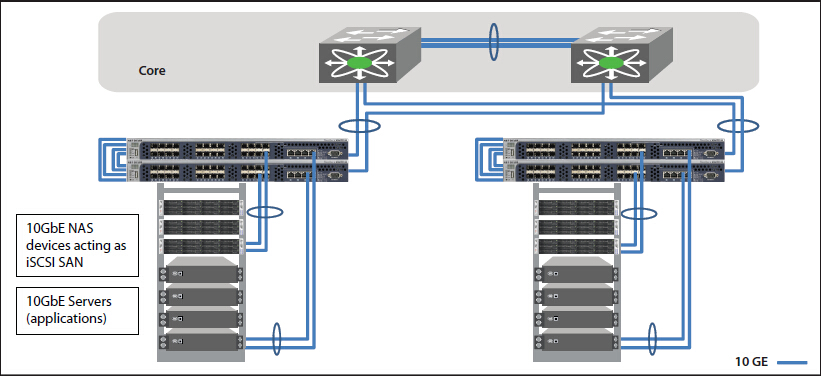10 Gigabit Ethernet, or 10GE and 10GbE, is a group of computer networking technologies for transmitting Ethernet frames at a rate of 10 gigabits per second. Nowadays, 10 Gigabit Ethernet is gaining broader deployments by the increasing bandwidth requirements and the growth of enterprise applications. But there is a question to be considered when deploying 10 Gigabit Ethernet — how to achieve a reliable, affordable and simple 10 Gigabit Ethernet deployment? The text below will tell the answer.
Server virtualization supports several applications and operating systems on a single server by defining multiple virtual machines on the server. Virtual machines grow and require larger amounts of storage than one physical server can provide. Storage area networks (SANs) or network attached storage (NAS) provide additional and dedicated storage for virtual machines. But connectivity between the servers and storage must be fast to avoid bottlenecks. 10 Gigabit Ethernet is able to provide fastest interconnectivity for virtualized environments.
The Internet Small Computer System Interface (iSCSI), an extension of SCSI protocol used for block transfers in most storage devices and Fibre Channel, is making 10 Gigabit Ethernet an attractive, alternative interconnect fabric for SAN applications. The iSCSI capabilities allow 10 Gigabit Ethernet to compare very favorably to Fibre Channel as a SAN interconnect fabric. 10GbE networking can reduce equipment and management costs as its components are less expensive than highly specialized Fibre Channel components and do not require a specialized skill set for installation and management.
10 Gigabit Ethernet allows the aggregation layer to scale to meet the increasing demands of users and applications. It can help bring oversubscription ratios back in line with network-design best practices, and provides some important advantages over aggregating multiple Gigabit Ethernet link, such as less fiber usage, greater support for large streams and longer deployment lifetimes.
For any fiber cable deployment, the types of fiber cable, 10 Gigabit Ethernet physical interface and optics module form factor need to be considered. Form factor options are interoperable as long as the 10 Gigabit Ethernet physical interface type is the same on both ends of the fiber link.
Currently, three different copper cabling technologies for 10 Gigabit Ethernet are available. 10GBASE-CX4 was the first 10 Gigabit Ethernet copper standard. CX4 was relatively economical and allowed for very low latency. Its disadvantage was a too-large form factor for high density port counts in aggregation switches. SFP+ direct attach cables (DAC) connect directly into an SFP+ housing. It has become the connectivity of choice for servers and storage devices in a rack due to its low latency, small form factor and reasonable cost. 10GBASE-T is able to run 10 Gigabit Ethernet over CAT6a and CAT7 copper cabling up to 100 meters, but it needs technology improvements to lower its cost, power consumption and latency.
SFP+ direct attach cables integrate SFP+ connectors with a copper cable into a low-latency, energy-efficient, and low-cost solution. Direct attach cables are currently the best cabling option for short 10 Gigabit Ethernet connections.
The Link Aggregation Control Protocol (LACP) standard defines a way of bundling several physical ports over one logical channel. From a deployment standpoint, it is far easier to implement a distributed LACP solution with stackable switches that allow link aggregation across the stack. In this configuration, the stack acts as a single logical switch and link aggregation is seamless.
The diagram below shows a stackable 10 Gigabit Ethernet ToR switching solution enabling cost-effective SAN connectivity for servers and network storage. In addition to better performance, LACP functionality provides better availability and redundancy for servers and storage. Moreover, it provides failover protection if one physical link goes down, while iSCSI traffic load balancing ensures greater transmission throughput with lower latency.

The diagram below shows Gigabit access switches with 10 Gigabit uplinks and stackable 10 Gigabit aggregation switches. At the edge, stacks of access switches are virtualized into a single switch, reducing configuration and management overhead.

To achieve a reliable, affordable and simple 10 Gigabit Ethernet deployment, the factors stated above need to be considered. Fiberstore SFP+ transceivers and SFP+ direct attach cables are ideal for cost-sensitive organizations considering 10 Gigabit Ethernet applications and they help growing companies support rising bandwidth requirements, new applications, and the demands of a fast-paced business environment.
